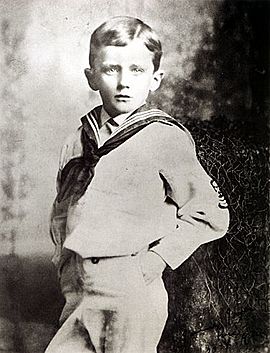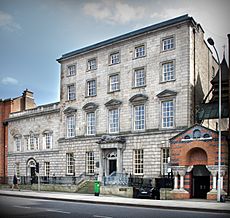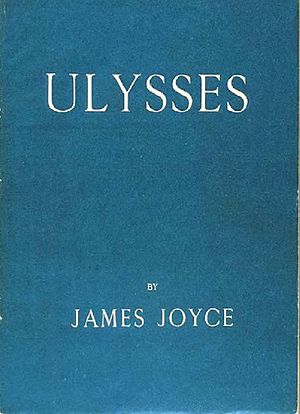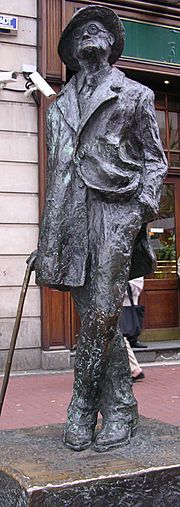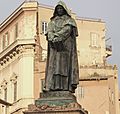James Joyce facts for kids
Quick facts for kids
James Joyce
|
|
|---|---|
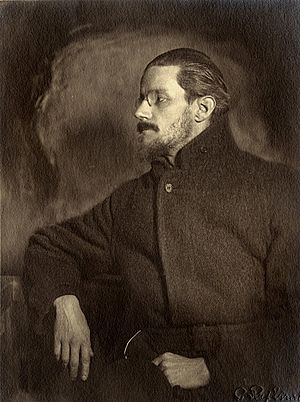
Joyce in Zürich, c. 1918
|
|
| Born | 2 February 1882 Rathgar, Dublin, Ireland |
| Died | 13 January 1941 (aged 58) Zürich, Switzerland |
| Occupation | Novelist, poet |
| Notable works | Dubliners (1914), A Portrait of the Artist as a Young Man (1916), Ulysses (1922), Finnegans Wake (1939) |
| Spouse | Nora Barnacle |
| Children | Giorgio, Lucia |
James Augustine Aloysius Joyce (born February 2, 1882 – died January 13, 1941) was a famous Irish writer. He wrote novels and poems. Many people think he was one of the most important writers of the 1900s.
Joyce's most famous book is Ulysses (1922). This novel tells a story that is like Homer's ancient Greek poem, Odyssey. He used a special writing style called stream of consciousness. This means the story shows the characters' thoughts as they happen.
Other well-known books by Joyce are Dubliners (1914), a collection of short stories, and the novels A Portrait of the Artist as a Young Man (1916) and Finnegans Wake (1939). He also wrote poetry, a play, and letters.
Joyce was born in Dublin, Ireland. He went to Jesuit schools, which are run by a Catholic group. He was very good at writing. In 1904, he met Nora Barnacle, who later became his wife. They moved to Europe. He taught English in places like Pula and Trieste.
During World War I, Joyce lived in Zürich, Switzerland. He worked on Ulysses there. After the war, he moved to Paris in 1920. This became his main home for many years.
Ulysses was first published in Paris in 1922. But it was not allowed to be published in the United Kingdom or the United States for a while. People had to sneak copies into these countries. It finally became legal to publish it there in the mid-1930s.
Joyce started his next big book, Finnegans Wake, in 1923. It took him 16 years to finish it. He and Nora got married in London in 1930. Joyce often traveled to Switzerland for eye treatments. He moved back to Zürich in 1940 during World War II. He died there in 1941.
Ulysses is often listed as one of the greatest books ever. Many writers and artists have been inspired by Joyce's unique style. He paid close attention to details. He also used interior monologue (showing a character's inner thoughts) and wordplay.
Even though he lived abroad, most of his stories are about Dublin. His characters are often like people he knew. He once said, "I always write about Dublin, because if I can get to the heart of Dublin I can get to the heart of all the cities of the world."
Contents
- Early Life: Growing Up in Dublin
- University Years: A Young Writer's Beginnings
- Life in Dublin After University
- Life in Europe: Trieste and Zürich
- Life in Paris and Final Years
- Death and Legacy
- Joyce's Ideas and Beliefs
- Major Works: A Look at His Books
- Joyce's Influence and Legacy
- Images for kids
- See also
Early Life: Growing Up in Dublin
James Joyce was born on February 2, 1882, in Rathgar, Dublin, Ireland. He was the oldest of ten children. His family was Catholic.
When he was five, his family moved to Bray, a town near Dublin. Around this time, a dog attacked him. This made him afraid of dogs for the rest of his life. He also became afraid of thunderstorms.
In 1891, when Joyce was nine, he wrote a poem called "Et Tu, Healy." His father printed it and shared it with friends. The poem showed his father's feelings about Irish politics.
His family faced money problems. His father lost his job. Joyce started school at Clongowes Wood College, a Jesuit boarding school. But he had to leave because his father could not pay. He then went to the Christian Brothers O'Connell School. Later, a Jesuit priest helped Joyce and his brother Stanislaus go to Belvedere College for free. Joyce was a great student there. He won awards for his writing.
University Years: A Young Writer's Beginnings
In 1898, Joyce started at University College. He studied English, French, and Italian. He learned about the ideas of Thomas Aquinas, which influenced him. He joined many writing groups in Dublin. Many people he met then later appeared in his books.
His first published work was a review of a play by Henrik Ibsen in 1900. Joyce admired Ibsen. He even wrote a play himself, but he later destroyed it.
In 1901, Joyce was 19. He lived with his parents and siblings in Clontarf. He became friends with Oliver St. John Gogarty. Gogarty later became a character in Ulysses. Joyce wrote an article criticizing Irish theater for not showing new plays. His college magazine would not print it. But others supported him.
Joyce finished university in 1902. He thought about studying medicine in Paris. But he soon decided to focus on writing. He spent time reading in libraries. He often wrote home asking for money.
Life in Dublin After University
In April 1903, Joyce's mother became very ill. He returned to Ireland to care for her. She died in August. After her death, Joyce's family life became difficult. He spent time with friends and tried to earn money by reviewing books.
Joyce's life changed when he met Nora Barnacle on June 10, 1904. She was a chambermaid from Galway. Their first date was on June 16, 1904. This date is now famous as "Bloomsday" in his novel Ulysses. This was the start of their 37-year relationship.
Joyce was also a good singer. In May 1904, he entered a music contest called the Feis Ceoil. He did well but refused to sing one song without practice. He still won a third-place medal. A judge said he had a great voice.
In 1904, Joyce worked on his writing. He tried to publish a story collection called Dubliners. He also started a novel called Stephen Hero. He wrote poems, but they were rejected. However, three of his short stories were published. These became the start of Dubliners.
In September 1904, Joyce moved into a tower near Dublin. But he left after a week because of a strange incident with his roommates. Soon after, Joyce and Nora left Ireland.
Life in Europe: Trieste and Zürich
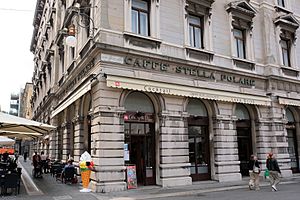
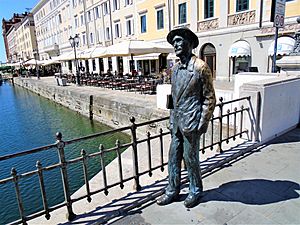
In October 1904, Joyce and Nora moved to Europe. They hoped to find work at a language school in Zürich. When that did not work out, Joyce found a teaching job in Pula, a naval base. Nora became pregnant soon after. Joyce did not like Pula. He moved to Trieste in March 1905.
In Trieste, Joyce taught English. He convinced his brother Stanislaus to join him. Stanislaus helped support Joyce's family. Joyce kept writing. He finished most of Dubliners. But he had trouble finding a publisher. Publishers worried about some parts of the book.
Trieste became like a second home to Joyce. He lived there until 1920, except for a few trips. He finished Dubliners and started A Portrait of the Artist as a Young Man. He also began working on Ulysses. Many details in Ulysses came from his observations of Trieste.
In 1906, Joyce briefly moved to Rome for a new job. He felt he did not achieve much there. But Rome gave him ideas for his stories, including "The Dead" and Ulysses. He returned to Trieste in 1907.
Back in Trieste, he taught English to Italo Svevo, another writer. They became good friends. Svevo helped Joyce with his writing. Joyce also wrote articles for a local newspaper. In 1907, his daughter Lucia was born.
Joyce continued to work on A Portrait of the Artist as a Young Man. He tried to get Dubliners published in Dublin. In 1909, he visited Dublin with his son Giorgio. He tried to start a cinema there, called the Volta Cinematograph. It did well at first but closed after he left.
From 1910 to 1912, Joyce still struggled financially. His long fight to publish Dubliners ended in 1912. The publisher refused to print it due to concerns about libel. Joyce never returned to Dublin after this.
His luck changed in 1913. A publisher named Grant Richards agreed to publish Dubliners. It came out on June 15, 1914. Around this time, he met Ezra Pound, a poet. Pound became a big supporter of Joyce's work. He helped Joyce get his books published and known.
Pound also helped publish A Portrait of the Artist as a Young Man in a magazine. Joyce finished this novel in 1914. He also started drafting Ulysses.
When World War I began in August 1914, Joyce stayed in Trieste. But in May 1915, Italy joined the war. Joyce moved his family to Zürich, Switzerland, which was neutral.
Life in Zürich During World War I
In Zürich, Joyce faced financial challenges. But he received money from supporters like Harriet Shaw Weaver. She helped him financially throughout his life. Joyce also had many eye surgeries during this time.
Zürich was full of artists and writers during the war. Joyce met many of them, like the sculptor August Suter and painter Frank Budgen. He used his experiences with them in Ulysses. He also met the writer Stefan Zweig.
Joyce continued to work on Ulysses. Parts of his novel A Portrait of the Artist as a Young Man were censored. But the whole book was published in 1916. In 1918, a magazine called The Little Review started publishing Ulysses in parts.
Joyce helped start an acting group called the English Players. They performed plays by Irish writers. Nora, his wife, even acted in one play. Joyce hoped they would perform his own play, Exiles.
By 1919, Joyce was having money problems again. Zürich had become expensive. He moved his family back to Trieste in October 1919. But Trieste had changed after the war. In June 1920, Joyce and his family moved to Paris.
Life in Paris and Final Years

Joyce and his family arrived in Paris in July 1920. He met Sylvia Beach, who owned a bookshop called Shakespeare and Company. Beach became very important to Joyce. She helped him financially and published his books.
Through Beach, Joyce joined the artistic community in Paris. He met Valery Larbaud, who helped translate Ulysses into French. Paris became the Joyces' home for 20 years.
Publishing Ulysses
Joyce finished Ulysses in late 1921. But it was hard to get it published. Parts of it had been stopped from being published in the US. In 1921, a court ordered the magazine to stop publishing Ulysses. The book was also banned in the United Kingdom until 1936.

Sylvia Beach agreed to publish Ulysses through her bookshop. She mailed copies to people who had ordered them. But postal workers in the US and UK often took the books. People had to smuggle them in. Because there was no copyright in the US, illegal copies were also printed. Ulysses was not legally published in the US until 1934.
Writing Finnegans Wake
In 1923, Joyce started his next book, Finnegans Wake. It was a very experimental novel. It took him 16 years to finish it. At first, he called it Work in Progress. Some of his friends and other writers did not like it. But others, like Samuel Beckett, supported it.

Joyce's health was poor in Paris. He had many eye operations and his vision got worse. He was almost blind in one eye. He worried he might not finish Finnegans Wake. He finally published it in 1939.
In 1930, Joyce and Nora got married in London. They had been together for 27 years. He wanted to make sure his son's inheritance was safe under British law.
Joyce often traveled to Switzerland for eye surgery or for his daughter Lucia's medical care. Lucia was very ill.
Final Return to Zürich
In the late 1930s, Joyce worried about the rise of fascism. He helped some Jewish people escape danger. When France was taken over by Germany in 1940, Joyce and his family moved back to Zürich.
Death and Legacy
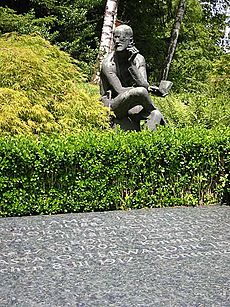
On January 11, 1941, Joyce had surgery in Zürich. He died two days later, on January 13, 1941. He was almost 59 years old.
He was buried in the Fluntern Cemetery in Zürich. His wife Nora and son Giorgio are buried next to him. After his death, the Irish government did not allow his body to be brought back to Ireland.
Joyce's Ideas and Beliefs
Joyce was always interested in Irish politics. He studied different ideas about society. He called himself a "socialist artist." He wrote about the effects of British rule in Ireland. He supported Ireland's fight for independence.
However, Joyce never changed his British passport for an Irish one. This was partly because a British passport was more useful for traveling. He also did not like the violence in Irish politics.
Joyce and Religion

Joyce had a complicated relationship with religion. He grew up Catholic but later stopped practicing. He said he found it hard to stay in the church. But his writing was still deeply influenced by his Catholic upbringing.
Even after he left Ireland, he sometimes went to church. He liked the ceremonies of some churches. Some people think he never fully left his faith. They believe his books show a Catholic feeling. Others think he was criticizing the church.
Joyce's answers about his faith were often unclear. Once, when asked if he left the Catholic Church, he said, "That's for the Church to say."
Major Works: A Look at His Books
What is Dubliners About?
Dubliners is a collection of 15 short stories. It was published in 1914. The stories show what life was like for middle-class people in Dublin in the early 1900s. At this time, Irish people were looking for their own identity. Joyce wanted to show them a true picture of themselves.
The stories often have a moment called an "epiphany." This is when a character suddenly understands something important about themselves or life. The first stories are about children. Later ones are about older people.
What is A Portrait of the Artist as a Young Man?
A Portrait of the Artist as a Young Man was published in 1916. It is a story about growing up. It follows the main character, Stephen Dedalus, from childhood to becoming an artist. It is partly based on Joyce's own life.
This novel shows early examples of Joyce's unique writing styles. These include stream of consciousness and interior monologue. These techniques show the character's thoughts and feelings.
What are Exiles and His Poetry?
Joyce wrote only one play, called Exiles. He started it in 1914 and published it in 1918. It explores a relationship between a husband and wife.
He also published three books of poetry. His first collection was Chamber Music (1907). It had 36 short poems. He also published "Gas from a Burner" (1912) and Pomes Penyeach (1927).
What is Ulysses About?
The story of Ulysses takes place on one day: June 16, 1904. It starts at 8 AM and ends after 2 AM the next morning. Much of the story happens inside the characters' minds. Joyce uses techniques like interior monologue and dialogue.
The novel has 18 parts. Each part uses a different writing style. Each part also relates to an episode in Homer's Odyssey. The main characters, Leopold Bloom, his wife Molly Bloom, and Stephen Dedalus, are like Odysseus, Penelope, and Telemachus. Joyce also used humor and satire in the book.
Ulysses is also a detailed look at Dublin in 1904. Joyce said that if Dublin were destroyed, it could be rebuilt using his book. He used his memory and old city guides to make his descriptions very accurate. This attention to detail and unique writing style made Ulysses very important in 20th-century literature.
What is Finnegans Wake About?
Finnegans Wake is an experimental novel. It pushes the boundaries of stream of consciousness and wordplay. It is written in a very unusual English. It uses many puns and words from different languages. This makes it challenging to read.
Many people think the book is like a dream. It does not have a clear plot or characters in the usual way. The book's ideas are influenced by Giordano Bruno and Giambattista Vico. Vico believed history moves in cycles. The book starts and ends with parts of the same sentence, showing this idea of cycles.
Joyce's Influence and Legacy
Joyce's work still has a huge impact on culture today. Ulysses has inspired many writers, painters, and filmmakers. It is often on lists of "Great Books." His writing has influenced authors around the world.
His novels are still studied and discussed by many literary experts. There are thousands of articles and books written about Joyce's work.
Every year on June 16, people celebrate "Bloomsday" in Dublin and other cities. This day honors the events in Ulysses.
Where Can You Learn More About Joyce?
The National Library of Ireland has a large collection of Joyce's writings and notes. The Museum of Literature Ireland (MoLI) in Dublin also has many exhibits about him. You can visit the James Joyce Centre in Dublin. There is also the James Joyce Tower and Museum in Sandycove. This tower is where the first scene of Ulysses takes place.
Images for kids
-
Monument to Giordano Bruno at the Campo de' Fiori by Ettore Ferrari. Joyce admired Bruno.
See also
 In Spanish: James Joyce para niños
In Spanish: James Joyce para niños


